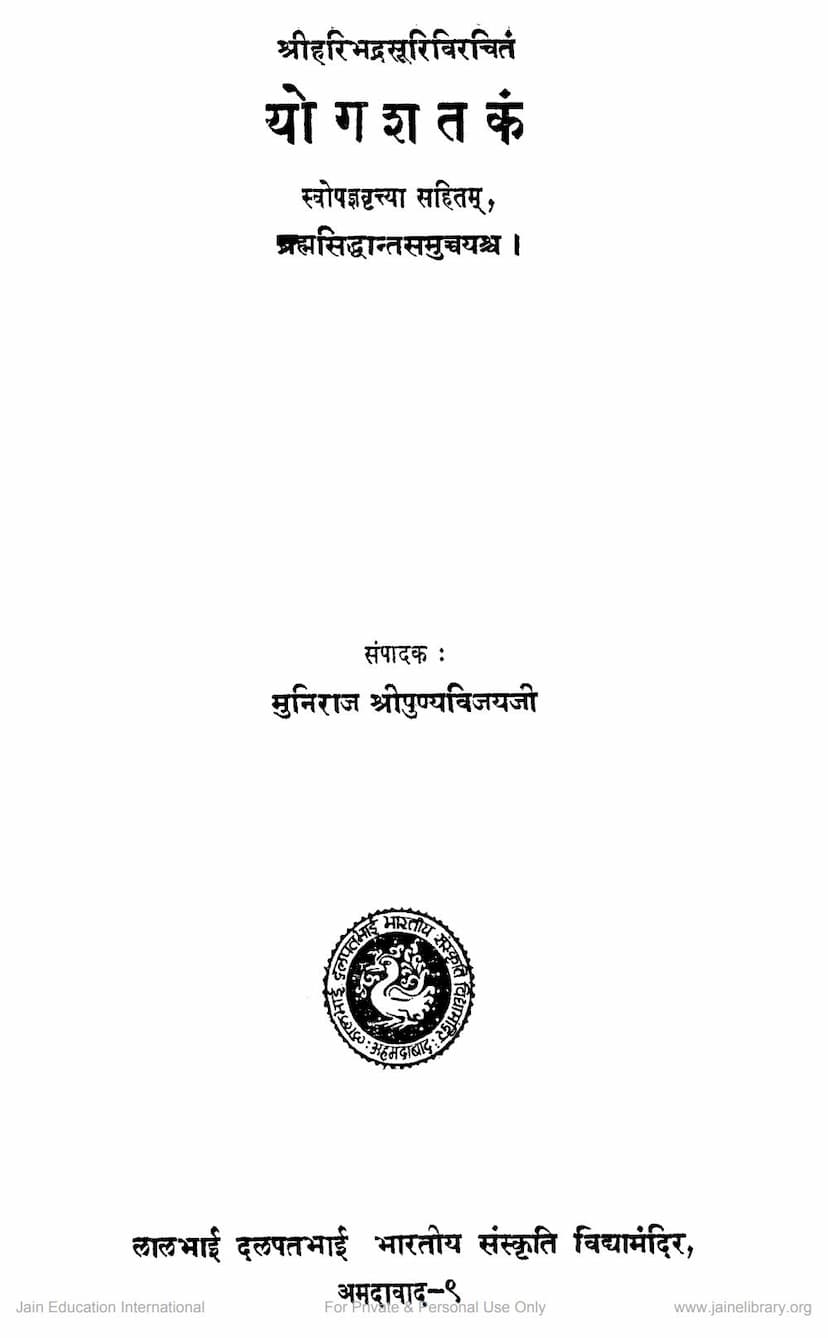Yogshatakam
Added to library: September 2, 2025

Summary
This document is a comprehensive summary of the Jain text Yogshatakam, authored by Haribhadrasuri and edited by Muni raj Shri Punyavijayji. The publisher is L D Indology Ahmedabad.
The work, presented in both Sanskrit and Prakrit, is a significant contribution to Jain Yoga literature. It includes the text of Yogashataka, its auto-commentary (Swopadnya Vritti), and an English translation of Yogashataka. Additionally, it features a newly discovered short treatise on Yoga, Brahmasiddhanta-samuccaya, also believed to be by Haribhadrasuri.
Key Aspects of the Text and its Context:
-
Author Acarya Haribhadra:
- Flourished in the 8th century.
- Originally a Brahmin priest from Citrakuta (Cittaur).
- Became a Jain monk after realizing the importance of Prakrit language and literature, influenced by a Jain nun named Yakini Mahattara.
- Known as Bhavavirahasuri due to his teachings emphasizing detachment from worldly life.
- A prolific writer, composing numerous works on various subjects in Sanskrit and Prakrit, aiming to enhance purity of conduct and thought.
- His works cover philosophy, ethics, didactic teachings, yoga, and narrative stories.
- He played a crucial role in preserving and illuminating Jain canonical works through commentaries and editing.
-
Yogshatakam:
- This work specifically focuses on Jain Yoga.
- Haribhadra gathered insights from various contemporary Yoga traditions to enrich Jain Yoga literature.
- It is considered one of his most outstanding Yoga works.
- The current edition is based on a newly discovered manuscript of the auto-commentary on Yogashataka, found in a Jain library in Mandvi (Cutch), dating back to Samvat 1165 (1108 CE). This manuscript has clarified earlier readings and provided the original, true form of the text.
- The text, along with its auto-commentary, was meticulously edited by Muni Shri Punyavijayaji, who has dedicated significant time and energy to this endeavor.
- The English translation of Yogashataka was provided by Dr. K. K. Dixit.
- Dr. Indukala Jhaveri has written an insightful introduction to this edition.
-
Brahmasiddhanta-samuccaya:
- This treatise is included in the edition because it was discovered in a fragmented state, and its authorship is attributed to Acarya Haribhadra based on textual analysis.
- The manuscript of this work was found in pieces from a collection of old manuscripts in Anhilpur Patan.
- The discovered manuscript is incomplete, containing up to verse 423.
- Its dating is estimated to be the 12th century based on script and writing style.
- The title "Brahmasiddhanta-samuccaya" itself is a conjecture by the editors based on the content of the text.
- The stylistic and terminological similarities with Haribhadra's confirmed works like Yogadrstisamuccaya and Yogabindu strongly suggest his authorship.
-
Content and Significance of Haribhadra's Yoga Works:
- Haribhadra's approach to Yoga was unique, not merely expounding Jain Yoga but also offering a comparative study of Yoga in general, including Vedic and Buddhist traditions.
- He introduced new terminology and styles in Jain Yoga literature.
- His works aim to establish the fundamental unity underlying diverse Yoga traditions.
- Key themes discussed in his Yoga works (including Yogabindu, Yoga-drstisamuccaya, Yogashataka, and Yogavimshati) include:
- The nature of Nishcaya-yoga (definitive yoga) and Vyavahara-yoga (practical yoga).
- The qualifications for yoga practice (yogadhikarin), categorizing them into stages like Apunarbandhaka, Samyag-dṛṣṭi, Caritri, etc.
- The preliminary preparations for yoga (Purva-seva or Yogabija), including worship of preceptors, deities, good conduct, penance, and non-antipathy towards liberation.
- The stages of spiritual development and the different types of yogins.
- The comparative analysis of Jain Yoga with Sāmkhya-Yoga and Buddhist Yoga, highlighting common principles and terminology.
- Discussions on omniscience (Sarvajñatva) and liberation (Moksha), presenting Haribhadra's liberal views that transcended sectarian boundaries.
- Haribhadra's contribution lies in his comprehensive and comparative study of Yoga, harmonizing Jain Yoga with broader Indian philosophical traditions and using new terminology to describe spiritual disciplines.
The preface and introduction emphasize the scholarly effort behind this edition, the importance of Haribhadra's contribution to Yoga studies, and the historical context of Yoga practices in ancient India. The text itself delves into the nuances of spiritual discipline, the path to liberation, and the conduct expected of various spiritual aspirants within the Jain framework, drawing parallels with other philosophical schools.